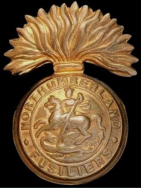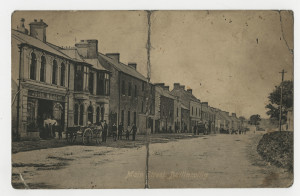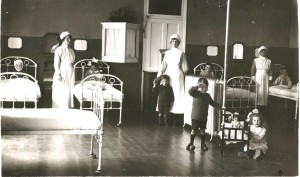John (always known as Jack) was born at Lilburn Hill Farm, near Wooler where his father worked as a groom. Jack was baptised at St Mary’s Church, Wooler on the 27th November 1895. By the time Jack reached school aged (5 years), his family had relocated to Spindlestone Farm, near Belford and he attended the local school until leaving at the age of 13 years. Jack worked with his father as a horseman, firstly at Spindlestone Farm and then at Blubbery Farm, near Morpeth until the outbreak of the Great War.
The exact date that Jack enlisted into the Army is not known as his service record was destroyed in the London Blitz during World War 2. It is known that he joined the Northumberland Fusiliers and was placed in the newly formed 8th Battalion soon after the war had started as he was awarded the 1914-15 Star in addition to the British War and Victory medals.
His First World War Medal Index Card shows that Jack’s first ‘theatre of war served in’ was in Egypt from the 16th July 1915. This entry caused confusion when researching as no evidence could be found of the Fusiliers being in Egypt at that time. Eventually contact was made with the Fusiliers’ Museum in Alnwick Castle who provided the following information from the Battalion’s War Diaries:
“The 8th Battalion sailed from Liverpool on 3rd July 1915, arriving at the Greek island of Lemnos on the 10th July 1915. The Battalion remained here until the 6th August, when they embarked for Gallipoli aboard two Destroyers.”
The diary entries of the 10th and 11th July go on to record:
“10th – Arrived at MUDROS BAY and anchored. Orders received that the base would be at ALEXANDRIA. All G.S. (General Service) Limbered Wagons (except “cookers” and water carts), men’s kit bags, Officer’s 100lb kits would be sent to base. 1 Non Commissioned Officer & 4 men to accompany them.”
“11th – Disembarked and went into bivouac on LEMNOS island. Sent one additional man to ALEXANDRIA to look after transport wagons.”
The museum archivist goes on to say:
“It may be that your grandfather was one of these five men who left the rest of the Battalion for the base in Alexandria, thus making Egypt his first “Theatre of War”. Indeed, I cannot think of any other reasons why this Northumberland Fusilier should find himself in Egypt at this point during the war. The only other Northumberland Fusilier Battalion known to have served in Egypt was the 2/7th Battalion, though they did not land there until January 1917.”
Although the diaries do not name the soldiers sent to Alexandria, the information above plus the theatre of war recorded on Jack’s Medal Index Card has convinced the researcher that Jack was in Egypt in July 1915.
Family knowledge indicates that Jack fought in France. This would have come about by Jack re-joining the rest of the 8th Battalion which had been withdrawn from Gallipoli at the end of 1915 to defend a section of the Suez Canal in Egypt. In July 1916, the Battalion left Egypt for France where they were used as reinforcements in the battle of The Somme (1916) and the battles of Messines (1917) and Passchendaele (1917).
Further family information indicates that Jack was back home with his family in March 1918. It is not known if he was on home leave or recuperating from possible wounds. What is known is that he took the opportunity of being home to marry his fiancé, Martha Bell. The marriage taking place on 30th March at St John’s Church, Ashington.
Soon after the wedding, Jack returned to France where his Battalion were involved in the Second Battle of the Somme and the Battles of the Hindenburg Line.
By the time Jack returned to his wife in Ashington, he was a father for the first time, daughter Ivy being born at the beginning of January 1919 at Martha’s family home in Sycamore Street. Shortly afterwards, Jack, Martha and baby Ivy moved to a home of their own in Council Terrace, Ashington. By now, unable to obtain work as a horseman, Jack found himself working as a coal miner hewer at nearby Ashington Colliery.
 In July 1919, Ashington Council held a Victory Parade and celebrations for the returning servicemen. Each serviceman was given a silver medal by the Council depicting a soldier and a sailor with the inscription:
In July 1919, Ashington Council held a Victory Parade and celebrations for the returning servicemen. Each serviceman was given a silver medal by the Council depicting a soldier and a sailor with the inscription:
“Ashington Sailors & Soldiers Great War 1914 – 1919 Welcome Home”
Over the next three years, Jack and Martha added to their family, William born in October 1920 (sadly dying in 1922) and Robert born in October 1922.
Jack continued working as a coal miner at Ashington Colliery, but sadly died in March 1924 of Phthsis Pulmonalis (Tuberculosis) leaving Martha with daughter Ivy (age 5 years) and son Robert (age 17 months).
Jack was laid to rest in the churchyard of St. John, Hirst, Ashington on the 16th March.
We would like to express our sincere appreciation to Allan Robinson for supplying this article for our Northumberland At War Project.







